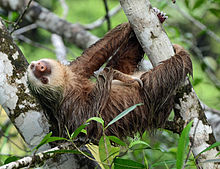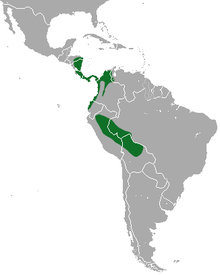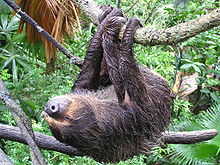Hoffmann's two-toed sloth
| Hoffmann's two-toed sloth[1] | |
|---|---|
 | |
| At La Selva Biological Station, Sarapiqui, Costa Rica. | |
Conservation status | |
 Least Concern (IUCN 3.1)[2] | |
Scientific classification | |
| Kingdom: | Animalia |
| Phylum: | Chordata |
| Class: | Mammalia |
| Order: | Pilosa |
| Family: | Megalonychidae |
| Genus: | Choloepus |
| Species: | C. hoffmanni |
Binomial name | |
Choloepus hoffmanni Peters, 1858 | |
 | |
| Hoffmann's two-toed sloth range | |
 Play media
Play mediaHoffmann's two-toed sloth climbing in a cage at Ueno Zoo (video)
Hoffmann's two-toed sloth (Choloepus hoffmanni) is a species of sloth from Central and South America.
It is a solitary, largely nocturnal and arboreal animal, found in mature and secondary rainforests and deciduous forests. The common name commemorates the German naturalist Karl Hoffmann.
Contents
1 Description
2 Distribution and habitat
2.1 Subspecies
3 Behavior
4 Life history
5 Diet
6 Conservation status
7 Reproduction
8 Adaptation
9 References
10 Further reading
11 External links
Description
Hoffmann's two-toed sloth is a heavily built animal with shaggy fur and slow, deliberate movements. The fore feet have only two toes, each ending with long, curved claws, although three clawed toes are on each of the hind feet. Other features that distinguish it from three-toed sloths, which may be found in the same geographic areas, include the longer snout, separate rather than partially fused toes of the forefeet, the absence of hair on the soles of the feet,[3] and larger overall size. The wrist of the sloth has developed some specific traits due to their slow, yet acrobatic motions. These evolved traits include diminution and distal migration of the pisiform bone, with a loss of contact with the ulna; reduction of the distal end of the ulna to a styloid process; and extremely reduced contact between the ulna and triquetral bone.[4]
Hoffmann's two-toed sloth is, however, much easier to confuse with the related Linnaeus's two-toed sloth, which it closely resembles. The primary physical differences between the two species relate to subtle skeletal features; for example, Hoffmann's two-toed sloth has three foramina in the upper forward part of the interpterygoid space, rather than just two,[3] and often – but not always – has fewer cervical vertebrae.[5]
Adults range from 54 to 72 cm (21 to 28 in) in head-body length, and weigh from 2.1 to 9 kg (4.6 to 19.8 lb). Although they do have stubby tails, just 1.5 to 3 cm (0.59 to 1.18 in) long, this is too short to be visible through the long fur. The claws are 5 to 6.5 cm (2.0 to 2.6 in) long. Females are larger on average than males, although with considerable overlap in size. Their fur is tan to light brown in colour, being lighter on the face, but usually has a greenish tinge because of the presence of algae living in the hairs.[6]
Its karyotype has 2n = 49–51 and FN = 61.[3]
Distribution and habitat
Hoffmann's two-toed sloth inhabits tropical forests from sea level to 3,300 m (10,800 ft) above sea level.[2] It is found in the rainforest canopy in two separate regions of Central and South America, separated by the Andes. One population is found from eastern Honduras[2] in the north to western Ecuador in the south, and the other in eastern Peru, western Brazil, and northern Bolivia.[3] Based on cytochrome c oxidase subunit I sequences, a divergence date of about 7 million years between these populations has been suggested.[7] Two-toed sloths live in the canopies in the forests of the tropical rainforests. They usually tend to be relaxing in the branches of the trees that are intertwined within each other throughout the sheltering treetops. Most of the two-toed sloths activity takes place hanging upside down but when it comes time for urination and defecation they make their way to the ground. These creatures also come to the ground when in need of a new tree to live upon or to discover a new food source [8]
Subspecies
The five recognised subspecies of C. hoffmanni are:[3]
C. h. hoffmanni, Peters, 1858 – Honduras, Nicaragua, Costa Rica, Panama
C. h. agustinus, Allen, 1913 – Venezuela, western Colombia, northern Ecuador
C. h. capitalis, Allen, 1913 – western Ecuador
C. h. juruanus, Lönnberg, 1942 – Brazil, Bolivia, extreme eastern Peru
C. h. pallescens, Lönnberg, 1928 – Peru
Behavior

C. h. hoffmanni, high in Monteverde canopy
Two-toed sloths spend most of their time in trees, though they may travel on the ground to move to a new tree. A study of sloths on Barro Colorado Island indicated that the Hoffmann's two-toed sloths there were almost exclusively nocturnal, even though in other locations they are known to be active during day.[9] The authors attributed this in part to competition with the brown-throated sloth.[9] They often move slowly through the canopy for about eight hours each night, and spend much of the day sleeping in tangles of lianas. They move only very slowly, typically at around 0.14 m/s (0.46 ft/s), although they can move up to 50% faster when excited. They are solitary in the wild, and, aside from mothers with young, it is unusual for two to be found in a tree at the same time.[3]
The name "sloth" means "lazy", but the slow movements of this animal are actually an adaptation for surviving on a low-energy diet of leaves. These sloths have half the metabolic rate of a typical mammal of the same size. Sloths have very poor eyesight and hearing, and rely almost entirely on their senses of touch and smell to find food.[citation needed]
This species often exhibits exaggerated wobbling of the head. Another trait of this sloth is it often spits when the mouth opens. The saliva often accumulates on the lower lip, giving the creature a comical appearance.[citation needed]
Two-toed sloths hang from tree branches, suspended by their huge, hook-like claws. The clinging behaviour is a reflex action, and sloths are found still hanging from trees after they die. The sloth spends almost its entire life, including eating, sleeping, mating, and giving birth, hanging upside down from tree branches. Usually, sloths are found right side up when they descend to the ground to defecate, which they usually do about once every three to eight days.[3] They will also ground themselves to urinate, change trees if they wish, or mate, as well as give birth.[10] While terrestrial locomotion is usually thought to involve the sloth lying on the ground and pulling themselves forward, they have actually been seen walking on their palms and soles.[11]
Sloths have many predators, including the jaguars, ocelots,[12]harpy eagles,[13]margays, and anacondas.[3] If threatened, sloths can defend themselves by slashing out at a predator with their huge claws or biting with their sharp cheek teeth. However, a sloth's main defense is to avoid being attacked in the first place. The two-toed sloth can survive wounds that would be fatal to another mammal its size. The sloth's slow, deliberate movements and algae-covered fur make them difficult for predators to spot from a distance. Their treetop homes are also out of reach for many larger predators.[citation needed]
Their long, coarse fur also protects them from sun and rain. Their fur, unlike other mammals, flows from belly to top, not top to belly, allowing rainwater to slide off the fur while the animal is hanging upside down.[citation needed]
Hoffmann's two-toed sloth inhabits a range of different trees within its habitat, although it seems to prefer those with plentiful lianas and direct sunlight. They have a typical home range of about 2 to 4 ha (4.9 to 9.9 acres), and may spend most of their lives travelling between just 25 or so trees.[3]
Life history

In Manuel Antonio National Park, Costa Rica

Young sloth being raised in a wildlife rescue centre on the Gulf of Dulce, Costa Rica
Courtship consists of the female licking the male's face and rubbing her genitals against the male's body. Gestation lasts between 355 and 377 days, and results in the birth of a single young. The birth takes place on either the ground or in the hanging position.[14] Newborn sloths weigh 340 to 454 g (12.0 to 16.0 oz), and are precocial, already possessing long claws and able to cling to their mothers' undersides. They begin to take solid food at 15 to 27 days, and are fully weaned by 9 weeks.[15] Although relatively quiet as adults, young sloths make loud bleating alarm calls if separated from their mothers.[3]
In captivity, the two-toed sloth was seen giving birth by hanging upside down and attempting to pull the infant between her hind limbs and onto her abdomen. Other sloths were seen hanging under the mother and infant to protect the infant from falling.[14]
Hoffmann's two-toed sloths reach sexual maturity at two to four years of age[15] and have been reported to live up to 43 years in captivity.[16]
Diet

Suspended from a branch
Though two-toed sloths also eat fruits and flowers, most of their diets consist of tree leaves. They use their lips to tear off their food and chew with their peg-like teeth which have no enamel and are always growing. Although they are not true ruminants, sloths have three-chambered stomachs. The first two chambers hold symbiotic bacteria to help them digest the cellulose in their fibre-rich diets, while only the third chamber contains digestive glands typical of the stomachs of most other mammals.[3] A sloth may take up to a month to completely digest a meal, and up to two-thirds of a sloth's weight may be the leaves in its digestive system.[citation needed]
Conservation status
Habitat destruction is probably causing a decrease in the wild Hoffmann's two-toed sloth population, but little reliable data is available on the number of wild individuals. Sloths and people have little contact with one another in the wild.
Reproduction
The reproduction process of the toe-toed sloths has some differences when compared to the three-toed sloths. Two toed sloths tend to mate all year around; they don’t really go by a schedule. If they had to pick the most popular season to mate it would be during rainy seasons and give birth in the dry seasons. The female carries the baby for typically 11.5 months[17]. When the females are ready to mate, they let out a loud scream which attracts the males; if numerous males are ready to mate, they fight each other; after done mating, the male will usually leave. The female is the one who solely takes care of the baby sloth until they are independent and don’t need the mother anymore. For the first 6-9 months of birth, mother sloth is carrying the baby and nurturing it until they are capable of being on their own. Sloths are sexually matured by the age 3 and are ready to start reproducing of their own [18]
Adaptation
Sloths are known to be heterothermic, meaning that whatever environment they’re in, the learn to adapt. Their body temperature ranges from 86-93 degrees Fahrenheit, which, compared to other mammals is on the cold side. Having these low temperatures, helps the sloths conserve their energy. Sloths fur is grown specifically for a job which is to grow algae. The algae grows within their hair shaft and benefits the creatures camouflaging techniques. The hair grows in a special system of being parted along the stomach and flows from belly to back. This systems is helpful for when they sloths are hanging upside down and the rainwater can run off[19]
References
^ Gardner, A.L. (2005). "Order Pilosa". In Wilson, D.E.; Reeder, D.M. Mammal Species of the World: A Taxonomic and Geographic Reference (3rd ed.). Johns Hopkins University Press. p. 101. ISBN 978-0-8018-8221-0. OCLC 62265494..mw-parser-output cite.citation{font-style:inherit}.mw-parser-output .citation q{quotes:"""""""'""'"}.mw-parser-output .citation .cs1-lock-free a{background:url("//upload.wikimedia.org/wikipedia/commons/thumb/6/65/Lock-green.svg/9px-Lock-green.svg.png")no-repeat;background-position:right .1em center}.mw-parser-output .citation .cs1-lock-limited a,.mw-parser-output .citation .cs1-lock-registration a{background:url("//upload.wikimedia.org/wikipedia/commons/thumb/d/d6/Lock-gray-alt-2.svg/9px-Lock-gray-alt-2.svg.png")no-repeat;background-position:right .1em center}.mw-parser-output .citation .cs1-lock-subscription a{background:url("//upload.wikimedia.org/wikipedia/commons/thumb/a/aa/Lock-red-alt-2.svg/9px-Lock-red-alt-2.svg.png")no-repeat;background-position:right .1em center}.mw-parser-output .cs1-subscription,.mw-parser-output .cs1-registration{color:#555}.mw-parser-output .cs1-subscription span,.mw-parser-output .cs1-registration span{border-bottom:1px dotted;cursor:help}.mw-parser-output .cs1-ws-icon a{background:url("//upload.wikimedia.org/wikipedia/commons/thumb/4/4c/Wikisource-logo.svg/12px-Wikisource-logo.svg.png")no-repeat;background-position:right .1em center}.mw-parser-output code.cs1-code{color:inherit;background:inherit;border:inherit;padding:inherit}.mw-parser-output .cs1-hidden-error{display:none;font-size:100%}.mw-parser-output .cs1-visible-error{font-size:100%}.mw-parser-output .cs1-maint{display:none;color:#33aa33;margin-left:0.3em}.mw-parser-output .cs1-subscription,.mw-parser-output .cs1-registration,.mw-parser-output .cs1-format{font-size:95%}.mw-parser-output .cs1-kern-left,.mw-parser-output .cs1-kern-wl-left{padding-left:0.2em}.mw-parser-output .cs1-kern-right,.mw-parser-output .cs1-kern-wl-right{padding-right:0.2em}
^ abc Plese, T.; Chiarello, A. (2014). "Choloepus hoffmanni". IUCN Red List of Threatened Species. IUCN. 2014: e.T4778A47439751. doi:10.2305/IUCN.UK.2014-1.RLTS.T4778A47439751.en. Retrieved 27 August 2016.
^ abcdefghijk Hayssen, V. (2011). "Choloepus hoffmanni (Pilosa: Megalonychidae)". Mammalian Species. 43 (1): 37–55. doi:10.1644/873.1.
^ The wrist joint of two-toed sloths and its relevance to brachiating adaptations in the hominoidea. Journal of Morphology. Volume 162, Issue 3, pages 413–424, December 1979.
^ Maslin, A.; et al. (2007). "Morphological and molecular analysis of vertebral variants in the two-toed sloths Choloepus hoffmanni and Choloepus didactylus". Journal of Vertebrate Paleontology. 27 (3): 113A. doi:10.1080/02724634.2007.10010458. JSTOR 30126393.
^ Gilmore, D.P.; et al. (2001). "Sloth biology: an update on their physiological ecology, behaviour and role as vectors of arthropods and arboviruses". Brazilian Journal of Medical Biological Research. 34 (1): 9–25. doi:10.1590/S0100-879X2001000100002. PMID 11151024.
^ Moraes-Barros, N.; Arteaga, M. C. (2015-06-01). "Genetic diversity in Xenarthra and its relevance to patterns of neotropical biodiversity". Journal of Mammalogy. 96 (4): 690–702. doi:10.1093/jmammal/gyv077.
^ "Hoffman's Two-Toed Sloth". www.macalester.edu. Retrieved 2019-02-26.
^ ab Sunquist, M.E.; Montgomery, G.G. (November 1973). "Activity Patterns and Rates of Movement of Two-Toed and Three-Toed Sloths (Choloepus hoffmanni and Bradypus infuscatus)". Journal of Mammalogy. 54 (4): 946–954. doi:10.2307/1379088. JSTOR 1379088. – via JSTOR (subscription required)
^
Use of Hands and Feet of Two-Toed Sloths (Choloepus hoffmanni) during Climbing and Terrestrial Locomotion Frank C. Mende;l Journal of Mammalogy. Vol. 62, No. 2 (May, 1981), pp. 413-421. Published by: American Society of Mammalogists
^ Use of Hands and Feet of Two-Toed Sloths (Choloepus hoffmanni) during Climbing and Terrestrial Locomotion. Frank C. Mendel; Journal of Mammalogy. Vol. 62, No. 2 (May, 1981), pp. 413-421. Published by: American Society of Mammalogists
^ Moreno, R.S.; et al. (2006). "Competitive release in diets of ocelot (Leopardus pardalis) and puma (Puma concolor) after jaguar (Panthera onca) decline". Journal of Mammalogy. 87 (4): 808–816. doi:10.1644/05-MAMM-A-360R2.1.
^ Touchton, J.M.; et al. (2002). "Foraging ecology of reintroduced captive-bred subadult harpy eagles (Harpia harpyja) on Barro Colorado Island, Panama". Ornitologica Neotropical. 13 (4): 365–379.
^ ab Brazilian Journal of Medical and Biological Research Gilmore, D.P., Da-Costa, C.P., & Duarte, D.P.F.. (2000). An update on the physiology of two- and three-toed sloths. Brazilian Journal of Medical and Biological Research, 33(2), 129-146. Retrieved April 17, 2013, from http://www.scielo.br/scielo.php?script=sci_arttext&pid=S0100-879X2000000200001&lng=en&tlng=es. 10.1590/S0100-879X2000000200001
^ ab Taube, E.; et al. (2001). "Reproductive biology and postnatal development in sloths, Bradypus and Choloepus: review with original data from the field (French Guiana) and from captivity". Mammal Review. 31 (3–4): 173–188. doi:10.1111/j.1365-2907.2001.00085.x.
^ http://www.adelaidenow.com.au/news/south-australia/adelaide-zoos-sloth-dies-last-one-in-australia/news-story/20eb0bbc999b1f2656b9f784a511e106
^ Apostolopoulos, Vicky. "Choloepus hoffmanni (Hoffmann's two-toed sloth)". Animal Diversity Web. Retrieved 2019-02-26.
^ Apostolopoulos, Vicky. "Choloepus hoffmanni (Hoffmann's two-toed sloth)". Animal Diversity Web. Retrieved 2019-02-26.
^ "Hoffman's Two-Toed Sloth". www.macalester.edu. Retrieved 2019-02-26.
Further reading
Emmons, Louise H.; Feer, François (1997-09-02). Neotropical rainforest mammals. A field guide (2nd ed.). Chicago: University of Chicago Press. pp. 44–45. ISBN 978-0-226-20721-6. OCLC 44179508.
Peery, Zachariah; Pauli, Jonathan (September 2012). "The mating system of a 'lazy' mammal, Hoffmann's two-toed sloth". Animal Behaviour. 84 (3): 555–562. doi:10.1016/j.anbehav.2012.06.007.
Hanley, Christopher S.; Siudak-Campfield, Joanna; Paul-Murphy, Joanne (2008). "Immobilization of free-ranging Hoffmann's two-toed and brown-throated three-toed sloths using ketamine and medetomidine: a comparison of physiological parameters". Journal of Wildlife Diseases. 44 (4): 938–945. doi:10.7589/0090-3558-44.4.938. PMID 18957650.
External links
| Wikimedia Commons has media related to Choloepus hoffmanni. |
Wikispecies has information related to Choloepus hoffmanni |
- View the sloth genome in Ensembl
- View the choHof1 genome assembly in the UCSC Genome Browser.